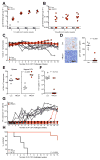Vectored immunoprophylaxis protects humanized mice from mucosal HIV transmission
- PMID: 24509526
- PMCID: PMC3990417
- DOI: 10.1038/nm.3471
Vectored immunoprophylaxis protects humanized mice from mucosal HIV transmission
Abstract
The vast majority of new HIV infections result from relatively inefficient transmission of the virus across mucosal surfaces during sexual intercourse. A consequence of this inefficiency is that small numbers of transmitted founder viruses initiate most heterosexual infections. This natural bottleneck to transmission has stimulated efforts to develop interventions that are aimed at blocking this step of the infection process. Despite the promise of this strategy, clinical trials of preexposure prophylaxis have had limited degrees of success in humans, in part because of lack of adherence to the recommended preexposure treatment regimens. In contrast, a number of existing vaccines elicit systemic immunity that protects against mucosal infections, such as the vaccines for influenza and human papilloma virus. We recently demonstrated the ability of vectored immunoprophylaxis (VIP) to prevent intravenous transmission of HIV in humanized mice using broadly neutralizing antibodies. Here we demonstrate that VIP is capable of protecting humanized mice from intravenous as well as vaginal challenge with diverse HIV strains despite repeated exposures. Moreover, animals receiving VIP that expresses a modified VRC07 antibody were completely resistant to repetitive intravaginal challenge by a heterosexually transmitted founder HIV strain, suggesting that VIP may be effective in preventing vaginal transmission of HIV between humans.
Conflict of interest statement
The authors declare no competing financial interests.
Figures



Comment in
-
One shot forward for HIV prevention.Nat Med. 2014 Mar;20(3):241-2. doi: 10.1038/nm.3503. Nat Med. 2014. PMID: 24603794 No abstract available.
References
-
- Gray RH, et al. Probability of HIV-1 transmission per coital act in monogamous, heterosexual, HIV-1-discordant couples in Rakai, Uganda. Lancet. 2001;357:1149–1153. - PubMed
-
- Pilcher CD, et al. Brief but efficient: acute HIV infection and the sexual transmission of HIV. J INFECT DIS. 2004;189:1785–1792. - PubMed
-
- Kilmarx PH. Global epidemiology of HIV. Current Opinion in HIV and AIDS. 2009;4:240–246. - PubMed
Publication types
MeSH terms
Substances
Grants and funding
LinkOut - more resources
Full Text Sources
Other Literature Sources
Medical

